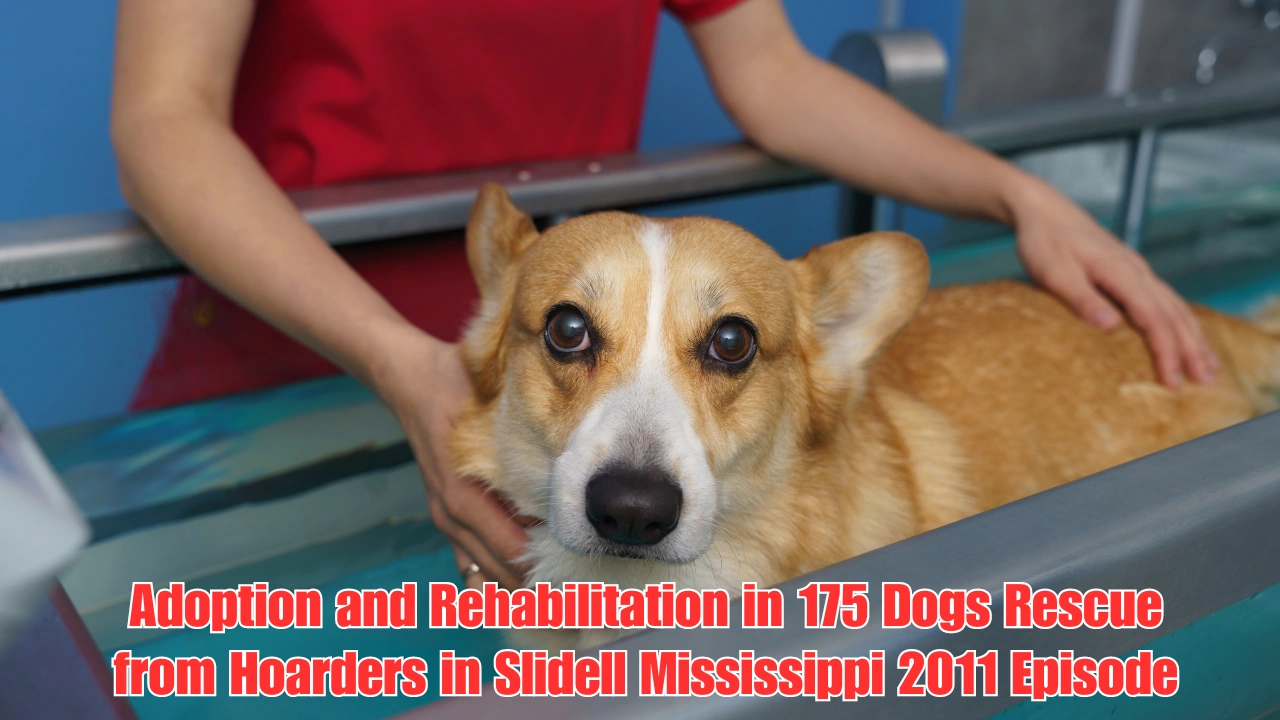175 Dogs Rescue from Hoarders in Slidell Mississippi 2011 Episode: Rescue

In 2011, a tragic yet pivotal event unfolded in the small town of Slidell, Mississippi. The 175 dogs rescue from hoarders in Slidell Mississippi 2011 episode became a defining moment in the fight against animal hoarding and neglect. This event was not only shocking in terms of the number of animals involved, but it also shone a light on the disturbing conditions in which these dogs were found. The rescue marked a turning point in animal welfare efforts in Mississippi, emphasizing the need for vigilance and stricter laws around animal care.
The Discovery of the Hoarding Case
The 175 dogs rescue from hoarders in Slidell Mississippi 2011 episode began when local authorities received complaints from neighbors who noticed unusual and concerning activity at a residential property. The stench from the house and the large number of dogs spotted on the premises alarmed the community. Upon investigation, animal control officers and law enforcement officials uncovered a disturbing scene: 175 dogs crammed into overcrowded, unsanitary spaces. The dogs were found living in their own waste, suffering from malnutrition, dehydration, and a variety of untreated medical conditions.
Hoarding is a serious issue that often stems from mental health challenges. In this case, the individuals responsible for the hoarding were overwhelmed, unable to care for the animals they had accumulated. While their intentions might have been good initially, the sheer number of animals led to severe neglect. As the conditions in the house deteriorated, the situation spiraled out of control, necessitating immediate intervention.
Why Did the Situation Get So Bad?
Animal hoarding often starts with good intentions. The individuals in this case likely wanted to care for the animals but quickly became overwhelmed. Without proper resources, the situation spiraled out of control. The conditions deteriorated, making it impossible to provide even the most basic necessities like food, water, and medical care. This is a common pattern in hoarding cases, which are usually driven by psychological factors such as anxiety or obsessive-compulsive tendencies. Hoarders may believe they are helping the animals, but the outcome is typically disastrous.
How Did the Rescue Operation Take Place?
The rescue operation that followed was monumental. The 175 dogs rescue from hoarders in Slidell Mississippi 2011 episode involved local animal control agencies, volunteers, and organizations such as the Humane Society of the United States (HSUS). The scale of the rescue was unlike anything the community had seen before, requiring significant resources and coordination.
Veterinary teams were brought in to provide immediate medical care. The majority of the dogs were malnourished, infested with parasites, and suffering from infections. Many of them had never received vaccinations, further complicating their health. Despite these challenges, the rescue teams worked tirelessly to ensure each dog received the necessary treatment.
Key actions during the rescue included:
- Setting up temporary shelters to house the dogs
- Administering emergency medical care, such as hydration and treatment for infections
- Using behavior specialists to help the dogs overcome the trauma they had experienced
For many of these dogs, the road to recovery would be long. Behavioral issues were common, as the dogs had lived in isolation and extreme conditions. However, thanks to the tireless efforts of the volunteers and animal welfare groups, hope was restored for these animals.
Conditions of the Dogs
When the dogs were first rescued, their condition was dire. Many of the animals were severely underweight, suffering from untreated injuries, skin conditions, and infections. Veterinarians conducted health checks on each dog, providing them with the necessary medical care to begin their recovery. One of the most heartbreaking aspects of the 175 dogs rescue from hoarders in Slidell Mississippi 2011 episode was seeing the emotional toll that the neglect had taken on the animals. Many were scared and aggressive, a result of their lack of socialization and the traumatic conditions they had endured.

Over time, with proper care and rehabilitation, the majority of these dogs began to recover both physically and emotionally. Some required extensive medical treatment, while others needed long-term behavioral support to regain trust in humans. This rescue showcased the resilience of animals, as many went on to thrive in loving homes after their rehabilitation.
How Did the Dogs Recover After the Rescue?
Once rescued, the recovery process for the dogs was extensive. Medical attention was provided to treat injuries and infections, and the dogs were gradually nursed back to health. However, the emotional scars were harder to heal. Many of the dogs had spent years in isolation, confined to small spaces with little to no human interaction. Behavioral rehabilitation was a critical component of their recovery, as these dogs needed to learn how to trust humans again.
Shelters and foster homes played a key role in helping the dogs recover. They were slowly introduced to caring environments where they could begin to socialize and adjust to life outside the hoarding situation. Adoption efforts were launched to find these dogs permanent homes, though the adoption process was carefully monitored to ensure the animals would not end up in similar situations.
Adoption and Rehabilitation
After the rescue, the focus shifted to finding permanent homes for the dogs. Adoption events were organized to connect these animals with families willing to provide them with the love and care they deserved. Local shelters, overwhelmed by the sheer number of dogs, received support from national organizations to ensure that every animal had the best chance of finding a forever home.

Many of the dogs rehabilitated from the 175 dogs rescue from hoarders in Slidell Mississippi 2011 episode went on to live happy, healthy lives with their new families. However, the process was not easy. Potential adopters had to be carefully screened, and many of the dogs required ongoing medical and behavioral care even after adoption.
What Impact Did This Rescue Have on the Community and Animal Welfare?
Here’s a table summarizing the impact of the 175 dogs rescue from hoarders in Slidell Mississippi 2011 episode on the community and animal welfare:
| Aspect | Impact |
|---|---|
| Legal Responsibilities | The hoarders were charged with animal cruelty, raising awareness about the legal responsibilities of pet owners. |
| Animal Welfare Laws | The case sparked discussions on improving animal welfare laws to prevent future hoarding incidents and ensure proper care for animals. |
| Mental Health Awareness | The incident highlighted the link between hoarding and mental health issues, such as OCD and anxiety, emphasizing the need for mental health interventions. |
| Community Involvement | The rescue raised awareness in the community, prompting more vigilance regarding animal welfare issues and greater support for animal rescue operations. |
| Dangerous Living Conditions | The hoarding situation created unsafe conditions not only for the animals but also for the hoarders themselves, showing the broader implications of such behavior. |
| Advocacy for Stronger Laws | Local and national organizations began advocating for stricter animal welfare laws and better mental health resources to prevent and address animal hoarding cases. |
This table summarizes the key legal, social, and psychological impacts of the rescue on animal welfare and community awareness.
Lessons Learned from the Rescue
The 175 dogs rescue from hoarders in Slidell Mississippi 2011 episode serves as a powerful reminder of the importance of community vigilance when it comes to animal welfare. It was the concerned neighbors who initially raised the alarm, leading to the discovery of the hoarding case. Without their intervention, these dogs might have continued to suffer in silence.
This incident also highlights the need for stronger laws and resources to address animal hoarding. Early intervention is crucial, as hoarding situations can quickly spiral out of control, resulting in severe neglect and suffering for the animals involved.
Conclusion
The 175 dogs rescue from hoarders in Slidell Mississippi 2011 episode was a monumental effort that saved the lives of countless animals and brought attention to the issue of animal hoarding. The rescue operation was a community-wide effort, involving local authorities, volunteers, and national organizations. Through the tireless work of these individuals, 175 dogs were given a second chance at life.
This event serves as a reminder of the importance of vigilance and compassion in protecting vulnerable animals. It also highlights the need for stronger animal welfare laws and better resources to address the mental health issues that often underlie hoarding behavior. The Slidell rescue will forever be remembered as a turning point in the fight against animal cruelty and neglect.
Frequently Asked Questions
How were the dogs rescued?
Local authorities, animal control, and volunteers coordinated to remove the dogs over several days, providing them with medical care and shelter.
What charges were brought against the hoarders?
The individuals responsible faced charges of animal cruelty for the severe neglect and poor living conditions of the dogs.
What role did mental health play in this case?
Animal hoarding is often linked to mental health issues like OCD or anxiety. The case highlighted the need for mental health interventions for hoarders.
Were the dogs adopted after the rescue?
Yes, after medical treatment and behavioral rehabilitation, many of the dogs were successfully adopted into loving homes.
